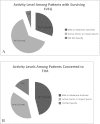The vascularized fibular graft in precollapse osteonecrosis: is long-term hip preservation possible?
- PMID: 22733182
- PMCID: PMC3441996
- DOI: 10.1007/s11999-012-2429-x
The vascularized fibular graft in precollapse osteonecrosis: is long-term hip preservation possible?
Abstract
Background: Osteonecrosis of the femoral head (ONFH) is a debilitating condition affecting primarily young patients. Free vascularized fibular grafting (FVFG) may provide a durable means to preserve the femoral head. When used in the precollapse stages of ONFH, this treatment may alter the course of disease.
Questions/purposes: We asked: (1) In what percentage of patients does FVFG preserve the femoral head beyond 10 years? (2) When long-term preservation is not achieved, what is the duration of femoral head preservation? (3) Do demographic or etiologic factors predict FVFG survivorship? (4) What long-term improvements in function and activity can be anticipated?
Methods: We retrospectively reviewed 61 patients (65 hips) who underwent FVFG for precollapse ONFH. We calculated graft survivorship, SF-12 scores, activity levels, and Harris hip scores. Minimum followup was 10.5 years (mean, 14.4 years; range, 10.5-26 years). Results Forty-nine of 65 hips (75%) had surviving FVFG for at least 10 years. At last followup, 39 of 65 hips (60%) had surviving FVFG, with a mean graft survival time of 15 years (range, 10.5-26.1 years). Twenty-six of the 65 hips with FVFG (40%) underwent conversion to THA at a mean of 8 years postoperatively. Demographic factors, lesion size, additional procedures, and low preoperative function were not associated with changes in graft survivorship. Pain and function were similar in patients with surviving FVFG and patients who had conversion to THA. Patients with surviving FVFG were more likely to engage in impact sports or active events than were patients who had conversion to THA.
Conclusions: When patients with precollapse ONFH undergo FVFG, the majority have preservation of the hip lasting for greater than 10 years with low levels of pain and reasonable function. In patients who ultimately undergo conversion surgery to THA, the mean duration of hip preservation before conversion is 8 years. We continue to use FVFG for treating patients younger than 50 years with symptomatic, precollapse ONFH.
Level of evidence: Level IV, therapeutic study. See Instructions to Authors for a complete description of levels of evidence.
Figures



Similar articles
-
Vascularized fibular grafts for avascular necrosis after slipped capital femoral epiphysis: is hip preservation possible?Clin Orthop Relat Res. 2013 Jul;471(7):2206-11. doi: 10.1007/s11999-012-2781-x. Epub 2013 Jan 16. Clin Orthop Relat Res. 2013. PMID: 23322187 Free PMC article.
-
Outcomes of free vascularized fibular graft for post-traumatic osteonecrosis of the femoral head.Injury. 2021 Dec;52(12):3653-3659. doi: 10.1016/j.injury.2021.04.005. Epub 2021 May 2. Injury. 2021. PMID: 34016425
-
Clinical results of free vascularized fibula graft in the management of precollapse osteonecrosis of the femoral head: A retrospective clinical study.Acta Orthop Traumatol Turc. 2022 Mar;56(2):105-110. doi: 10.5152/j.aott.2022.21012. Acta Orthop Traumatol Turc. 2022. PMID: 35416161 Free PMC article.
-
[Therapeutic progress of avascular osteonecrosis of the femoral head using a fibular graft by vascular anastomosis].Zhongguo Gu Shang. 2009 Jan;22(1):76-8. Zhongguo Gu Shang. 2009. PMID: 19203057 Review. Chinese.
-
Femoral head osteonecrosis: why choose free vascularized fibula grafting.Microsurgery. 2011 Mar;31(3):223-8. doi: 10.1002/micr.20837. Epub 2010 Oct 25. Microsurgery. 2011. PMID: 21400578 Review.
Cited by
-
[Early and late complications and their management in slipped capital femoral epiphysis].Orthopade. 2019 Aug;48(8):677-684. doi: 10.1007/s00132-019-03729-2. Orthopade. 2019. PMID: 31025044 Review. German.
-
Bone grafting for femoral head necrosis in the past decade: a systematic review and network meta-analysis.Int J Surg. 2023 Mar 1;109(3):412-418. doi: 10.1097/JS9.0000000000000231. Int J Surg. 2023. PMID: 36906744 Free PMC article.
-
Treatment of osteonecrosis in systemic lupus erythematosus: a review.Curr Rheumatol Rep. 2014;16(9):441. doi: 10.1007/s11926-014-0441-8. Curr Rheumatol Rep. 2014. PMID: 25074031 Review.
-
Osseoscopy: Direct Visualization to Assist Core Decompression and Debridement of Necrotic Bone Defects.Arthrosc Tech. 2017 May 15;6(3):e607-e612. doi: 10.1016/j.eats.2017.01.004. eCollection 2017 Jun. Arthrosc Tech. 2017. PMID: 28706806 Free PMC article.
-
Vascularized Greater Trochanter Bone Flap Transfer for Treatment of ARCO Stage-IIB to IIIB Osteonecrosis of the Femoral Head.JBJS Essent Surg Tech. 2019 Jun 12;9(2):e20. doi: 10.2106/JBJS.ST.18.00092. eCollection 2019 Jun 26. JBJS Essent Surg Tech. 2019. PMID: 31579538 Free PMC article.
References
-
- Aldridge JM, 3rd, Berend KR, Gunneson EE, Urbaniak JR. Free vascularized fibular grafting for the treatment of postcollapse osteonecrosis of the femoral head: surgical technique. J Bone Joint Surg Am. 2004;86(suppl 1):87–101. - PubMed
-
- Berend KR, Gunneson EE, Urbaniak JR. Free vascularized fibular grafting for the treatment of postcollapse osteonecrosis of the femoral head. J Bone Joint Surg Am. 2003;85:987–993. - PubMed
-
- Bozic KJ, Zurakowski D, Thornhill TS. Survivorship analysis of hips treated with core decompression for nontraumatic osteonecrosis of the femoral head. J Bone Joint Surg Am. 1999;81:200–209. - PubMed
MeSH terms
LinkOut - more resources
Full Text Sources
Research Materials

